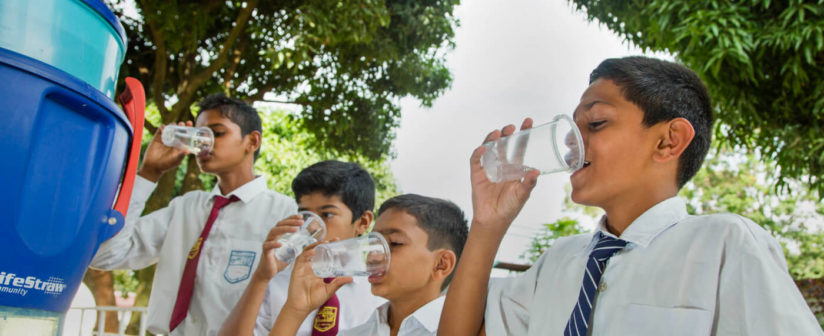No Sweat
Children are much more prone to dehydration than adults because their bodies don’t cool down as efficiently, and they are never more at risk than during the heat of summer. The danger arises when fluids are leaving the body through sweating faster than they are being replaced, and severe dehydration can be life-threatening. Taking a few simple precautions will protect your child and allow him to enjoy the summer fun safely.
Power Aid
Perhaps the best way to keep your child hydrated is to get her used to drinking liquids regularly. Offer healthy beverages at every meal and with snacks. And if you know a particularly busy or strenuous day is coming up in your child’s schedule, add some extra hydration in her first meal of the day or even the night before. The American College of Sports Medicine recommends drinking the equivalent of a standard bottle of water (16.9 oz.) about 2 hours before vigorous exercise.
Wet Their Whistles
Don’t wait until your child is thirsty to offer refreshment; by that time he is already dehydrated. Three studies by the University of Connecticut found that more than half of the children at sports camps were significantly dehydrated despite the availability of water and sports drinks and the encouragement to drink liquids. Get your child in the habit early on by scheduling frequent beverage breaks during activity, about every 20 minutes or so in hot weather. If possible, take all hydration breaks in a shady spot.
Raise a Glass
Following an organized game, kids are usually wild with excitement at a win or despondent in defeat. Keep your team focused by making a healthy beverage and snack part of the after-activity celebration or cooldown. Toast the efforts or success of the team to encourage your little athletes to drink the necessary quantities for good health.
Water Weight
How can you tell that your child is getting enough liquids? The American Academy of Pediatrics (AAP) recommends that children drink six glasses of water on an average day. During activity, however, your child can lose up to a half-liter of fluid per hour. The AAP suggests about 5 ounces (or two kid-size gulps) of water or a sports drink every 20 minutes for an 88-pound child. Kids and teens weighing about 132 pounds should drink 9 ounces.
Safety on Ice
Water is generally considered nature’s perfect drink and the best liquid for routine hydration. It’s inexpensive (often free), widely available, and suitable for everyone. When you pack a cooler for a game, freeze a number of water bottles ahead of time. The frozen bottles will keep the others cool and you will be able to pack more drinks in the cooler instead of filling the cooler with ice.
Keep in mind that while ice-cold beverages might seem like the perfect remedy for thirst, it’s much better to provide liquids at a moderate temperature. Those first cold sips might be refreshing but it’s hard for children (and even adults) to drink the necessary quantities at extreme temperatures.
Flavor Wins
Sports drinks might be your best bet for getting adequate amounts of liquids into your child during activities. Studies have shown that children routinely prefer flavored beverages to plain water and will drink up to 90 percent more when it is offered to them. Sports drinks also replace electrolytes lost from the body through sweating. Such beverages should be limited to use during athletic competitions or active play on a hot day, as they are generally high in carbohydrates and calories.
Banned from the Sport
When choosing drinks for kids, avoid those that have caffeine, such as iced tea or many sodas. As a diuretic, caffeine can contribute to the dehydration process by increasing fluid loss. In addition, as a stimulant, it can depress the symptoms of dehydration. Beverages such as soda or juice-flavored drinks might taste refreshing, but the high sugar content is unhealthy for many reasons and should be avoided for hydration except as a last resort.
Cool Idea
Kids can get caught up in their activities and are easily distracted by games, so chances are they won’t jump at the chance for a rest period. If you have a hard time convincing your child to take a break from play to drink a beverage, offer a Popsicle. These frozen treats have high water content (a two-stick Popsicle has just about the right amount for a young child’s needs), and their juicy flavors make them more appealing to kids.
Sweet Choices
Many fruits are excellent sources of water as well as being a nutritious snack. Offer fruits often during playtime and throw them in the cooler for after-game snacks. Fruit juice has a higher concentration of sugar than whole fruit and because of that, it’s not the best beverage choice for hydration during strenuous exercise. But the AAP (American Academy of Pediatric) does see a place for it among your options: for activity periods longer than three hours, the AAP suggests a drink of half water and half 100-percent juice.
Eat Your Veggies
Always include high-water-content foods in your daily meal planning to help your family stay well-hydrated at all times so strenuous activities don’t find them in a deficit. In addition to water, fruit, fruit juice, and many vegetables are excellent sources of hydration. Clear soup, especially when made with vegetables, offers an ideal way to get liquid into the diet along with
Winning Strategy
As they get older, you won’t be able to follow your kids everywhere to ensure they’re getting the liquids they need. But you can help them to understand the importance of hydrating frequently for good health. Instill in them early on the habits of frequent beverage breaks and choosing liquids wisely. Help those good habits along by always packing good sources of hydration into their lunchboxes or backpacks as not-so-subtle reminders to keep up the good work!
Source:














